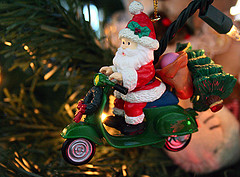Holiday Season of Death

A new report confirms that the Christmas-New Years holiday season perhaps should be renamed the season of death:
Christmas the deadliest day of the yearNational Post – Dec 20, 2010A new U.S. analysis of mortality rates during different times of year found that people are more likely to die during the holidays — notably on Christmas and New Year’s Day — and researchers cannot explain the yearly spike.
After analyzing all official United States death certificates over the 25-year period between 1979 and 2004, a trio of sociologists identified an excess of 42,325 natural deaths — that is, above and beyond the normal seasonal winter increase — in the two weeks starting with Christmas…
Mr. Phillips and two other University of California at San Diego researchers found another correlation between the holidays and a spike in deaths…
The researchers concluded: “These comparison measures indicate that the largest spikes in alcohol consumption and in SIDS … occur on New Year; alcohol consumption and SIDS increase significantly on weekends; and children of alcohol-consuming mothers are much more likely to die from SIDS than are children of non-alcohol-consuming mothers.” http://news.nationalpost.com/2010/12/20/christmas-the-deadliest-day-of-the-year-study/
While most people equate the Christmas-New Year’s season with family gatherings, gifts, parties, and religious stories, apparently death is a major part of it.
But, believe it or not, there was a direct element of death associated with this season prior to the birth of Jesus Christ.
Notice the following from Rod McNair of the Living Church of God:
Saturnalia’s Dark Echoes
Author Hugo Slim reminds us that Christmas “is perhaps the best example of the early Church Christianizing the traditional non-Christian festivals of a season—in this case the festivals of returning light surrounding the winter solstice” (A Feast of Festivals, pp. 36–37). The Romans celebrated the solstice season as the “Saturnalia, honoring Saturn, the god of agriculture” (Fillmore, p. 10).
This connection to the Saturnalia reveals an even darker side to Christmas traditions, and shows plainly why Christmas is not a child-friendly holiday! The Encyclopaedia Britannica explains that at the feast of Saturnalia, “all classes exchanged gifts, the commonest being wax tapers and clay dolls. These dolls were especially given to children…” (article: “Saturnalia,” 11th edition). What was the purpose of those gifts? “Varro thought these dolls represented original sacrifices of human beings to the infernal god. There was, as we have seen, a tradition that human sacrifices were once offered to Saturn, and the Greeks and Romans gave the name of Cronus and Saturn to a cruel Phoenician Baal, to whom, e.g. children were sacrificed at Carthage” (ibid.).
Child Sacrifice and Cannibalism?
Saturnalia—the festival Christmas absorbed—even carries echoes of ancient child sacrifice! It sounds horrific that dolls were given as gifts as symbols or proxies of children burnt to pagan gods. Yet this practice echoes the modern tradition of hanging cherubs or human figures on Christmas trees! The ancient Greeks placed small masks called oscilla on branches, where they could twirl freely in the wind. Encyclopaedia Britannica explains that oscilla were small figures, most commonly masks or faces, that were hung up “as offerings to various deities.… The custom of hanging these oscilla represents an older practice of expiating human sacrifice” (ibid.).
Not only did ancient Saturn-worship and fire-worship involve child sacrifice, it also included cannibalism. Author John Garnier noted: “Cannibalism appears to have been initiated by Cronus, i.e. Saturn… For we are told by Sanchoniathon that Cronus was the originator of human sacrifices… Saturn is represented as devouring his own children.” (The Worship of the Dead, pp. 34–35).
When “Christian” missionaries turned a blind eye to the symbols of ancient pagan festivals observed by their converts, they absorbed into their own worship and practice a number of ancient rites that echoed child sacrifice and cannibalism. Symbols of these abominable practices are still extant today as grim reminders of the “dark side of Christmas!”
Now, this is not to say that modern Christmas observers intentionally are carrying over remnants of a pagan death cult, but unintentionally is another matter. People rarely stop and ask themselves why they observe various traditions in their cultures.
Most people would be surprised to learn that Christmas was not observed by the early Christians, and that Catholic-associated writers like Tertullian condemned what is now the Christmas-New Years season as far back as approximately 200 A.D.
The fact that the Christmas-New Years season was associated with intentional death in ancient times and a rise in deaths in modern times is an interesting coincidence. Or is it more than a coincidence?
Some articles of possibly related interest may include:
What Does the Catholic Church Teach About Christmas and the Holy Days? Do you know what the Catholic Church says were the original Christian holy days? Was Christmas among them?
Is January 1st a Date for Christians Celebrate? Historical and biblical answers to this question about the world’s New Year’s day.
Did Early Christians Celebrate Birthdays? Did biblical era Jews celebrate birthdays? Who originally celebrated birthdays? When did many that profess Christ begin birthday celebrations?
Is There “An Annual Worship Calendar” In the Bible? This paper provides a biblical and historical critique of several articles, including one by WCG which states that this should be a local decision. What do the Holy Days mean? Also you can click here for the calendar of Holy Days.
 |
Tweet |
|